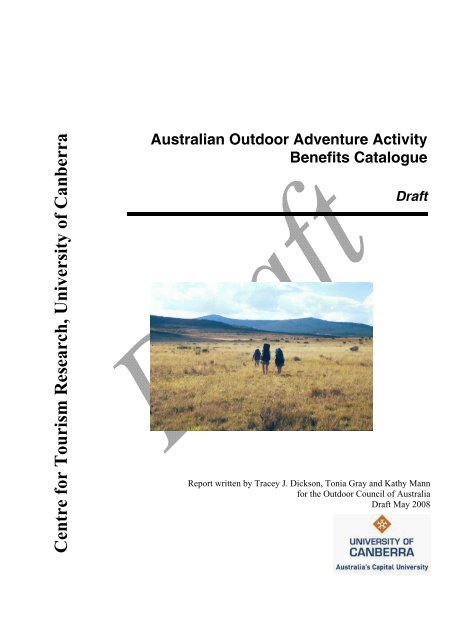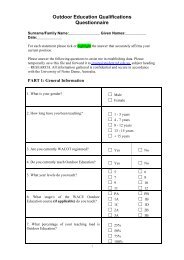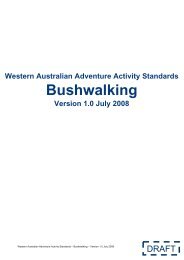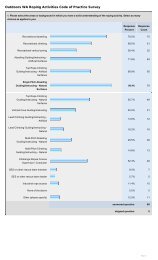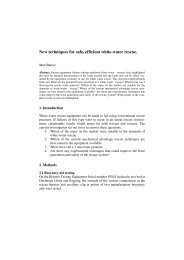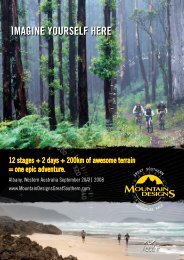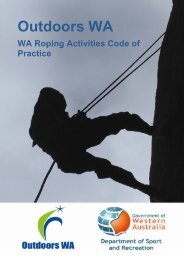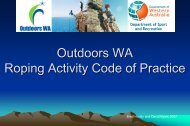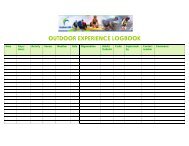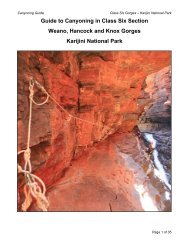Outdoor Adventure Activities Benefits Catalogue - Outdoors WA
Outdoor Adventure Activities Benefits Catalogue - Outdoors WA
Outdoor Adventure Activities Benefits Catalogue - Outdoors WA
Create successful ePaper yourself
Turn your PDF publications into a flip-book with our unique Google optimized e-Paper software.
Centre for Tourism Research, University of CanberraAustralian <strong>Outdoor</strong> <strong>Adventure</strong> Activity<strong>Benefits</strong> <strong>Catalogue</strong>DraftReport written by Tracey J. Dickson, Tonia Gray and Kathy Mannfor the <strong>Outdoor</strong> Council of AustraliaDraft May 2008
AcknowledgementsThis research was made possible by the support of the following sponsors:Page i
Index of TablesTABLE 1 BENEFITS OF OUTDOOR ADVENTURE (DARST & ARMSTRONG, 1980) ........................................3TABLE 2 BENEFITS OF OUTDOOR ADVENTURE (EWERT, 1989) .................................................................3TABLE 3 GOALS AND BENEFITS OF OUTDOOR ADVENTURE (WEBB, 1999)...............................................3TABLE 4 BENEFITS OF CAMPING (AMERICAN CAMP ASSOCIATION, 2005)................................................3TABLE 5 LITERATURE SEARCH TERMS.......................................................................................................5TABLE 6 COMPARISON OF BENEFITS CATEGORIES WITH OUTCOME MESSAGES, CANADA ..........................6TABLE 7 PARTICIPATION IN OUTDOOR ACTIVITIES, 2006.........................................................................20TABLE 8 EXAMPLES OF INITIATIVES RELATED TO PHYSICAL ACTIVITY AND BEING OUTDOORS ...............24Index of FiguresFIGURE 1 FREQUENCY OF PARTICIPATION IN KEY OUTDOOR ACTIVITIES, 2006 .......................................21FIGURE 2 FREQUENCY OF PARTICIPATION IN PHYSICAL ACTIVITY BY 15-24 YEAR OLDS, 2006 ...............21FIGURE 3 LEISURE CONSTRAINTS AND FACILITATORS .............................................................................23Page iii
Executive SummaryResearch into the benefits of outdoor adventure activities highlights the valuablecontribution they makes to personal health and wellbeing. As the empirical andanecdotal evidence in the outdoor adventure field begins to unfold, the proliferationof evidenced-based research grows exponentially. The unique opportunities within thenatural and social environments offered by outdoor adventure activities, providevarying contexts in which these positive connections are made. These connections arereferred to in the outdoor adventure literature as being with the self, others and theenvironment. <strong>Outdoor</strong> adventure activities provide opportunities for the connection ofindividuals with nature (the natural environment), direct connection with other people(interpersonal), and importantly, with themselves (personal). Specifically, the benefitsof these connections are shown to lie in the strength and placement of theseconnections.This report draws on research from education, recreation, leisure, tourism, sport,adult learning, health, and therapy to highlight the evidence of the positivecontributions of outdoor adventure activities. The authors acknowledge the combinedeffects of difficulties encountered when measuring experiences and benefits with thepaucity of Australian and New Zealand research in this area. This has meant a broadsweep of the available research to include both qualitative and quantitative studies,theoretical papers, and reports from complimentary disciplines and other countries.The evidence-based research reported on here used a variety of methods includingmeta-analyses, questionnaires (mostly utilising psychometric questioning e.g. LifeEffectiveness Questionnaire - LEQ), and in-depth interviews and were either crosssectionalor longitudinal in design.The main benefits of outdoor adventure activities, as shown in the evidence-basedliterature, include interpersonal and intrapersonal skills developed through engagingin outdoor adventure activities in meaningful ways. <strong>Benefits</strong> for the naturalenvironment were less directly evidenced, however indirectly were given asdeveloping more nurturing individuals and communities, and the development ofenvironmental awareness and stewardship. The long-term nature of changed attitudesto the environment and sustainability are yet to be examined through longitudinalresearch.<strong>Benefits</strong> were evident in the psycho-social, psychological, physical and spiritualdomains, particularly with regards to developing self efficacy, intellectual flexibility,personal skills, and relationship building. The benefits that result from participatingin outdoor adventure activities are facilitate through the provision of appropriatefacilities and natural resources and well as the design of programs that areintentionally working towards particular objectivesWhile there was a wide range of available research, what this review highlights is theneed to established a strategic interdisciplinary research agenda within whichresearchers, program and activity providers, land managers, policy advisors andother key stakeholders may conduct research and evaluation, and then disseminatethe knowledge for others to build upon.Page iv
2.1. <strong>Outdoor</strong> adventure activitiesIt should be stated at the outset of this review that the emphasis is upon human-poweredactivities in the outdoors. As such, there is a focus upon the active involvement in physicalactivities conducted in the outdoors. The authors are also cognizant of ‘feeder’ adventureactivities that may be indoors such as climbing gymnasiums and exercise bicycles. The maininterest of this review pertains to those activities occurring in natural or non-urbanenvironments. The reason for this latter emphasis is duplication of the substantial work byDeakin University, which is currently being updated, that has focused upon more urbanenvironments such as parks and gardens (Mallar, Townsend, Brown, & St Leger, 2002a,2002b).By focusing upon human-powered outdoor adventure activities, a wide range of possibleactivities are included such as hiking, mountain biking, climbing and canoeing. In seeking todefine ‘outdoor adventure’ Ewert (1989) made reference to a range of definitions thatincorporated elements of physical danger, creating meaningful human experiences,involvement in the outdoors, and facing a challenge. Terms such as outdoor recreation, aretotally artificial constructs (Mercer, 1994) that seek to place definitional limits over, often,blurred realities. For example, rock climbing is often considered an outdoor adventureactivity, however, with the proliferation of indoor climbing gyms, many people may use theequipment and techniques of rock climbing, but never actually venture outdoors to climb onnatural rock surfaces. By participating, albeit indoors, they may achieve similar benefits interms of physical activity, group cohesion and sense of ‘flow’ (Csikszentimihalyi, 1990) butwith less time and travel costs. While this review has focused upon outdoor adventureactivities, other research has been included that is not necessarily adventure, but still has beenthe element of human-powered activity conducted in the outdoors.The context in which these activities occur is also of importance. Again, using the broadestbrush possible, the research included in this review, as suggested by the methodology, hasbeen drawn from areas such as education, recreation, tourism, environment, religion, health,therapy and business and has occurred in protected areas, on the water, in remote areas and inurban environments2.2. <strong>Benefits</strong> frameworksThere have been a variety of models/frameworks used to analyse benefits of outdoor andadventure activities. These recent models and frameworks as presented in Stiehl and Parker(2007) have been summarised in Tables 1-4 over the page.The following sections of this report outline the methodology used to gather the wide range ofresearch and reports, followed by the presentation of the results. The results include asummary of seven previous reviews of the benefits of sport, recreation and exercise that havebeen conducted world-wide, followed by an analysis of the research and reports identified inthis review. Given the emphasis upon the health benefits of participating in outdooradventure activities, further information is presented about Australia’s efforts in relation tohealth and physical activity, including a summary of recent government policies andstrategies.Page 2
Table 1 <strong>Benefits</strong> of <strong>Outdoor</strong> <strong>Adventure</strong> (Darst & Armstrong, 1980)DimensionPersonalEconomicSocial-psychologicalBenefitNew experience – adds a kick to participants’ lives, allows then to experiencesomethingHigh-risk experience – facing perceived danger may help participants overcomefears, gain self-confidence, and enhance their ability to copeEscape – offers release form the tensions and complexities of modern lifeSuccess – allows participants to achieve a highly personal senses of accomplishmentKnowledge – participants learn more about themselves and the environmentPhysical fitness – physical activity can help burn calories and increase strength,stamina, and flexibilityMinimal financial investment – provides interesting and pleasant activities at areasonable costSocializing – provides a chance to meet others who have similar interestsUnity – promotes cohesiveness and doing things together without the distractions ofeveryday lifeCooperation and trust – promotes better relationships through cooperation,appreciation of others, compassion and respectNature and outdoors – promotes aesthetics appreciation for nature and concern forvanishing wild placesTable 2 <strong>Benefits</strong> of <strong>Outdoor</strong> <strong>Adventure</strong> (Ewert, 1989)DimensionPsychologicalSociologicalEducationalPhysicalBenefit<strong>Benefits</strong> on a personal (versus group) basis: Self concept (enhanced or strengthenedview), self-efficacy (self-confidence), self-actualisation (well-being, improved selfexpression,feelings of psychological health)Compassion, cooperation, respect for others, communicationImproved academic abilities, awareness of nature and the environment, problemsolving, outdoor skills, values clarificationStrength, co-ordination, balance, cardiovascular enduranceTable 3 Goals and <strong>Benefits</strong> of <strong>Outdoor</strong> <strong>Adventure</strong> (Webb, 1999)DimensionBenefitRecreationalEnjoyment, relaxation, entertainment, excitement, catharsis, self-expressionSkill Goal setting, decision making, problem solving, responsibility, physicaldevelopment, nature awareness, communication, leadershipCharacterIndependence, interdependence, self-efficacy, willingness to take risks, tolerance,respect, trust, compassionTable 4 <strong>Benefits</strong> of Camping (American Camp Association, 2005)DimensionPositive identitySocial skillsPhysical and thinkingskillsPositive values andspiritualityBenefitTo the participant: e.g. self-esteem, determination, dependability, ambition,independenceBeyond the individual: group bonding, cooperation, conflict resolution, appreciationof differences, leadership, community, connected to othersActivity skills, psychometer and technical skills; physiological benefits of physicalactivityThinking skills: knowledge of safety measures, planning, problem solving,environmental awarenessAcquiring and strengthening virtue; selflessness, compassion, keeping commitments,fulfilling obligations, self-discipline, honesty …Connection to earth, others and even a higher powerPage 3
was to get those in the fields of recreation, parks, sports, fitness, arts and culture to focus onoutcomes linked to 44 statements of outcomes and eight key marketing messages. The eightkey marketing, or outcomes, messages were linked to four categories of benefits identified inthe initial benefits catalogue (Table 6).Table 6 Comparison of benefits categories with outcome messages, CanadaEight key marketing messages Personal Social EconomicEnvironmental1. Recreation and active living are essential to personalhealth –a key determinant of health status2. Recreation is a key to balanced human development –helping Canadians reach for their potential3. Recreation and parks are essential to quality of life4. Recreation reduces self-destructive and anti-socialbehaviour5. Recreation and parks build strong families andhealthy communities6. Pay now or pay more later! Recreation reduces healthcare, social service, and police/justice costs7. Recreation and parks are significant economicgenerators in your community8. Parks, open spaces, and natural areas are essential toecological survival.Source: Canadian Parks/Recreation Association. (1997). 1997 <strong>Benefits</strong> of Parks and Recreation<strong>Catalogue</strong>It was suggested that the benefit of the catalogue, itself, was that it:• Reminded people in parks and recreation of the value of their work;• Acted as a basis for evaluation of various programs and services;• Influenced policies and the prioritisation of planning strategies;• Provided support when seeking support and funding;• Helped formed networks between groups and organisations doing similar work;• Provide marketing messages for outcomes-based products and services; and• Identified research gaps (Canadian Parks/Recreation Association, 1997).4.1.2. Best value through sport: The value of sport. London, UK, 1999Sport England (1999) adopted a very broad definition of sport as defined by the Council ofEurope’s European Sports Charter (Council of Europe, 2008) which defines sports as:…all forms of physical activity which, through casual or organised participation, aimat expressing or improving physical fitness and mental well-being, forming socialrelationships or obtaining results in competition at all levels. (Sport England, 1999, p.8)This definition includes all activities from recreational and casual participation to elitecompetitions, informal and formally structured activities. As such, they recognise the value ofsport, broadly defined, to the greater social agenda. The research reviewed highlighted thevalue of sport across four areas:• the global and international arena in terms of a country’s history, pride and folklore;• the social value from participation such as health outcomes, decreased crime rates,impacts upon young people’s education, the contribution of volunteers, as well as theeffect upon community cohesion and renewal;Page 6
4.1.5. A review of research on outdoor learning, 2004This UK report (Rickinson, Dillon, Teamey, Morris, Choi, Sanders, & Benefield, 2004) wasdriven by a concern that there had been a decline in opportunities for students in Englishschools to participate in outdoor learning activities. The authors reviewed 150 researchpublications on outdoor learning published in English between 1993-2003. This includedfieldwork and outdoor visits; outdoor adventure education; and school grounds andcommunity projects. <strong>Outdoor</strong> adventure education was considered to include ‘OutwardBound programmes, residential or day visits to outdoor activity centres, school-based outdooreducation lessons or clubs, wilderness trips and summer camps’ (2004, p. 27).In relation to outdoor adventure education, it was noted that the bulk of the researchoriginated from North America and Australasia. Two meta-analyses were noted for providingevidence of the impact of outdoor adventure programs in young people (Carson & Gillis,1994; Hattie, Marsh, Neill, & Richards, 1997). The connection to the development ofacademic outcomes was most evident where the aims of the program targeted specificacademic skills, though, of the research reviewed, there was little evidence supporting thedevelopment of the environmental awareness of participants. It was suggested that there was‘considerable evidence to suggest that outdoor adventure programs can impact positively onyoung people’s attitudes, beliefs and self-perceptions’ (2004, p. 27). As noted before, theimpact upon environmental awareness was limited where there was no intentional facilitationof environmental awareness – potentially, the mountains did not speak for themselves. Theevidence for cognitive and physical/behavioural outcomes was less robust than that associatedwith intrapersonal and interpersonal outcomes.4.1.6. Reconnecting children through outdoor education, 2007A driving force for this report, were the increasing disconnection of young people with theoutdoors, increased used of a variety of technologies such as video games and personalcomputers, rising rates of childhood obesity, ADD and ADHD. In response to these drivers,the Council of <strong>Outdoor</strong> Educators of Ontario (COEO), Canada conducted review ofevidenced based research on outdoor and experiential education (OEE) (Holmes, 2007). Itwas suggested that OEE:has many forms and takes places in a variety of local and remote, urban andwilderness settings – field centres, canoe trips, high school interdisciplinaryprograms, private camps, school-accredited Outward bound courses public agenciessuch as the YMCA, school ground greening projects and others. (Holmes, 2007, pp.8-9)Their findings highlighted the relationship between OEE and real-life situations. OEEstudents had better engagement and enthusiasm for learning; better results; and a greaterconnection with their achievements and improvements in critical thinking. Additionally,outcomes for physical, emotional and spiritual wellbeing were enhanced when students spentmore time outdoors in nature. Research had indicated that there could be improvements innutrition, physical activity, reductions in crime and ADD as a result of OEE.The key recommendations that emerged from this research review were:• that OEE, particularly when delivered by trained outdoor educators, needs to berecognised as an effective learning methodology;• that OEE should be imbedded across all school years and as a recognised area ofspecialisation; and• that government funding should be provided for two OEE programs for a total ofseven days.Page 8
To support these recommendations COEO also called for Canadian universities to helppromote additional Canadian research into the benefits, including long-term impacts, of OEE.4.1.7. Children and nature 2008: A report on the movement toreconnect children to the natural world, 2007Charles, Louv, Bodner and Guns’ (2008) report for the Children and Nature Network in SantaFe, New Mexico, builds upon the inspiring book Last child in the woods (Louv, 2006) thatseeks to save children from ‘nature-deficit disorder’, which they link to rising obesity levels,attention disorders and depression in young people. The movement to reconnect children tothe natural world seeks to ‘help shape a society in which the public once again considers it tobe normal and expected for children to be outside and playing in natural areas’ (Charles et al.,2008, p. 21). The biggest barrier to achieving this is fear. Other barriers identified includelack of natural resources; time pressures; electronic distractions; and, for some, ethnicity andcultural issues.The report highlights research that indicates that children in the 21 st century spend less timeoutdoors; have low levels of knowledge of nature and the outdoors; spend more time eachweek with computers and video games than with nature; are less likely to venture away fromtheir house to play; and have five times the rate of childhood obesity than in the 1960s.This research contrasts with the benefits identified of connecting and engaging with naturethat have included better health; better coping skills; reduced crime, encouraged curiosity;enhanced cognitive skills; improved academic outcomes; improvement in symptoms ofADHD, as well as the restorative value of ‘green exercise’. Meaningful engagement withnature as a child also has a direct correlation with involvement in environmental issues in thefuture which is of great interest as communities look for the next generation of environmentalleaders and activists.4.2. Australian and New Zealand research, 1995-2008The research and the reports considered in this review have drawn upon literature from arange of disciplines including, education, health, recreation, tourism, therapeutic programs.Commensurately the activities and the programs have been conducted from urban towilderness environments, over time-periods ranging from a few hours to a full year. Theactivities were conducted both on the land and in the water. As this review includes groupsfrom a therapeutic context through to recreational settings, the group sizes also varied greatly.The participants in this research covers people across all age groups, in groups that includedvoluntary participation through to mandated involvement.While previous analyses have used broad structures of self, others and the environment, giventhe diverse literature considered here, the findings will be presented under the headingsrelated to the program or activity context: education, recreation, health and therapy.4.2.1. EducationThere is a great range of programs conducted within educational contexts that have been thesubject of recent research. These include Duke of Edinburgh style programs (Bailey, 2004),extended stay outdoor education programs (ESOEP’s) (Gray, 1997; McLeod & Allen-Craig,Page 9
2007), environmental education centres (Ballantyne & Packer, 2007), cross-curriculumprograms (Eglington & Broderick, 2008; Haddock, 2007a) as well as more traditional outdooreducation programs (Hales, 2006; Haskell, 2000; Purdie, Neill, & Richards, 2002).As can be expected from such diverse programs, the outcomes that have been reported arealso wide-ranging. Improved relationships with self and others were identified as a result ofparticipation in a Duke of Edinburgh program (Bailey, 2004), while self-confidence andproblem solving skills had been enhanced in concert with gains in academic achievement as aresult of students involvement in outdoor education programs (Haddock, 2007a, 2007b). Themost common method used to measure changes in this areas is the Life EffectivenessQuestionnaire (LEQ) (Bailey, 2004; McLeod & Allen-Craig, 2007; Outward BoundAustralia, 2007a, 2007b). The LEQ is a 16 item self-report questionnaire that measures eightdimensions:• Time management;• Social competence;• Achievement motivation;• Intellectual flexibility;• Task leadership;• Emotional control;• Active initiative;• Self-confidence.Programs that had a more personal development orientation have often been evaluated usingthe LEQ. In a long-stay outdoor education program for boys in year 9 (n=104), it was foundthat the program was effective in enhancing participants’ life effectiveness skills of thoseparticipating in outdoor education when compared to a non-outdoor education programs. Theresults showed a statistically significant difference (p
Neill and Richards (1998) created a summary of meta-analyses of the effects of outdooreducation programs. The three meta-analyses involved over 12,000 participants of mixedgroups, ages, varied levels of experiences, course durations and types. An analysis oftypically measured outcomes such as personal development, changes in self-concept, selfconfidence and locus of control revealed small to medium impacts on the aspects.On average, outdoor education programs appear to have a small to moderateeffect on participants' perceptions of their own qualities andcapabilities…(roughly equivalent to … other types of self-concept changeprograms). These results are a positive endorsement of outdoor education as alegitimate and effective educational training method... <strong>Outdoor</strong> educationdefinitely has something to offer. (Neill and Richards, 1998, p7)Important factors influencing the outcomes of outdoor education programs were programdesign and facilitation; program length (longer programs produce better outcomes); age ofparticipants (adult participants tend to achieve larger outcomes). There was some evidence tosupport adventure therapy approaches such as finely tailoring programs to suit participantsand applying therapeutic principles in the programming and facilitation of outdoor adventureactivities.Purdie, Neill and Richards (Purdie et al., 2002) conducted a quantitative study (n=177) usingthe ROPE and SDQ-II instrumentation. The aim of the research was the investigation of selfexpressedidentification with Australia following an outdoor education program. Theysurmised:If there is not a fit between a participants' self-conceptions on the one hand (e.g.whether or not they identify as Australian and what this means to them) and whatappears to be on offer in an outdoor education program on the other hand, thenthe chances of successfully achieving program aims may be reduced. ... it wasparticipants’ senses of Australian-ness that was related to program outcome, andnot the other background variables of gender, motivation and previousexperience in the outdoors. (Purdie et al., 2002 p.38)Lugg (1999) reviewed the Victorian Certificate of Education (VCE) outdoor educationcurriculum. It was considered that the Victorian outdoor education curriculum is “graduallyevolving and in the process is developing a strong ideological basis, a distinctive body ofknowledge and a coherent sequence of learning" (p.31). More recently, Gough (2007)conducted an historical account of outdoor education studies in the Victoria educationdepartment and found that environmental education fostered relationships with the naturalenvironment whilst enhancing personal and social development.Zink (2005) interviewed cohorts of secondary school-aged participants from two differentoutdoor adventure programs in New Zealand. The first program involved year eightparticipants in a four-day residential program involving confidence course, a day walk,kayaking, initiatives, an overnight camp and climbing. The objectives of the first programwas to encourage cooperative relationships between the students, develop and apply skills forparticipating in challenging outdoor activities and develop and demonstrate responsibleattitudes when participating in outdoor activities. The second program involved year twelveparticipants in a seven-day camp with sea kayaking and tramping (bushwalking). Theobjectives of the second program were to promote strong bonds between class members,develop skills in sea kayaking and bush craft, experience and develop an appreciation for thePage 11
unique environment, develop trip planning and risk management skills and promote furtherparticipation in outdoor activities.The findings from the two interviews highlighted the importance of the participants’ synthesisof the outdoor adventure experience in the context of the activity and the camping programoverall. Zink (2005) concludes that the expected benefits of outdoor education (cooperation,bonding, skill development, planning and risk management) should be taken within thecontext of what is happening for the participants, rather than what ought to happen.4.2.2. AdultsTertiary studentsDickinson (2000) studied the emotional responses of a group of tertiary students (20-25 years,n=12) who participated in a six day sea kayak program on Hinchinbrook Island. Participantsreported more emotional episodes induced by the environment than due to any other factor.Dingle and Kiewa (2006) conducted semi-structured interviews with nine university studentson a river paddling journey. There were differences in the reported experiences of thefemales and males, with the females indicating that social fear was a powerful inhibitor in risktaking and learning. Social fear also impacted upon confidence and competence. Toovercome these barriers, the instructional staff and the attitudes of the participants wasimportant.Other adultsLeberman and Martin (2003) explored participants’ understandings of peak learning andcomfort zones within adventure activities. Using qualitative open-ended questions in twodifferent Outward Bound courses operating in the Czech Republic (mixed group n=25) andNew Zealand (female group n=28). The age range for the Czech cohort was 18-34 whilst theNew Zealand cohort ranged from 18-48. Although the physical activities took participantsoutside their comfort zones, it was found that greater learning was derived from the moregeneric aspects of a program (e.g. group work and reflections). They caution, that althoughthe physical activities provide opportunities for participants to be moved outside of theircomfort zone to experience other realities, the design of the learning program shouldincorporate mechanisms for additional learning.Little and Schmidt (2006) undertook a phenomenologically-inspired interpretative studyusing unstructured in-depth interviews with ten participants (7=females, 3=males). The aimwas to examine the “meaning” and “nature” of travel experience that was described asspiritual by participants who were aged 32-68 years. According to Little and Schmidt (2006),respondents gained an enhanced awareness of self, God or 'other' and felt a greater sense ofconnection with something beyond the self.In an attempt to get a deeper understanding of the improvements in quality of life derivedfrom leisure participation, Lloyd and Little (2005) conducted semi-structured in-depthinterviews with 20 females aged 26-65 years. They hypothesize that ‘access to opportunitiesto participate in leisure contributed to a sense of quality of life’ (Lloyd and Little, 2005,p.172). Interestingly, the outdoor recreation activities gave women an opportunity to createand experience a balanced life by enabling them to have fun, escape routines, satisfy personalneeds; gain greater self-confidence and a sense of competence. They purport thatPage 12
longitudinal research is needed to examine the issues of quality of life (QOL) and women 'sparticipation rates. However, the most salient issue of their research is that "findings dosupport previous studies that have shown that engagement in leisure has a positive impact onQOL and how women's QOL is enhanced by participation on social, and physical leisure"(Lloyd and Little, 2005, p. 176).Kane and Tucker (2007) interviewed 12 renowned New Zealand adventurers aged 41-88years (10 males, 2 females). Their findings showed that the natural environment is animportant “facilitating” and “distinguishing feature” in the adventure experience. Theiridentity as an adventurer had been influenced by their relationship with the environment. Theparticipants revealed that adventure had played an important role in challenging what isconsidered normal and formal in society. To this end, the authors maintain that adventure is"a vital component of human success and ongoing sustainability" (Kane and Tucker, 2007,p.37).People with DisabilitiesPeople with access requirements, include those with permanent or temporary disabilities,seniors who may have mobility needs and also families with young children in prams.Together these can include up to 35% of the population at anyone time (Dickson, 2007a).Dickson cited previous research by Disable WinterSport Australia (D<strong>WA</strong>) that indicated thatD<strong>WA</strong>’s members desired to be able to participate in summer activities in the alpine areas. ‘In2004, 60% of respondents indicated that they were interested in summer activities in thealpine areas, while in 2006 30% indicated they would like to try canoeing or camping in thewilderness; 28% horse riding; 26% mountain biking; 25% sailing; 23% hiking, climbing MtKosciuszko or abseiling and 22% fishing’ (Dickson, 2007a, p. 10). This research reflects thebroader understanding in the leisure and tourism areas that people with access requirementshave the same desire for opportunities to participate in outdoor activities, and also gain thesame or greater benefits.Harris (2006a; Harris, 2006b) explored the perceptions of people (n=17) with disabilities whoparticipated in an eight day Outward Bound program in New Zealand. The program includedbush-walking, rock-climbing, rafting, sailing and high ropes. The participants ranged in agefrom 18-38 years. Data was collected using both quantitative and qualitative methods: theLife Effectiveness Questionnaire (LEQ) (measure one moth pre-course, during course, oneweek post course and three months post course), focus groups, in-depth interviews,observations and journal entries. The greatest change in the LEQ was in intellectualflexibility, with significant differences in emotional control, social competence, achievementmotivation, active initiative, and self-confidence. From the qualitative data it was concludedthat the debriefing and feedback sessions provided the catalyst for change as it was a forum inwhich participants heard how others perceived them. The combination of achievingsomething thought beyond one’s abilities in a supportive environment, being able to expressthoughts and feelings created a sense of achievement and personal motivation thatparticipants believed they would be able to apply in all other areas of their lives..4.2.3. Recreation, sport and provision of facilitiesRecreation and sportUnderstanding the motivations and experiences of participants is important when seeking toprovide outdoor programs or experiences to facilitate particular outcomes. Kiewa (2001)undertook a qualitative study employing in-depth interviews and diary entries of adult rock-Page 13
climbers. She analysed the responses of 17 males and 14 females over a 12-month period inan attempt to develop an understanding of the effects of gender on how personal meaning ofclimbing is constructed. The study found that outdoor adventure programs should beconstructed with the view that "…both men and women will benefit from programmesdesigned to support skills associated with the opposite gender" (Kiewa, 2001, p.11).The doctoral study of Boyle (2002) investigated the effectiveness of adventure-based trainingon the development of team cohesion and the development of psychological skills. An elitenetball team aim and their coaching staff (n=36) undertook an intensive weekend adventurebasedtraining activities. The program incorporated initiative games, indoorclimbing/abseiling, giant swing, run, swim, bushwalk, overnight camp, caving. Theparticipants gained improved communication skills, effective application of psychologicalskills in high-pressure situations and identified benefits that were applicable to both netballand other life situations. Boyle (2002) concludes that adventure-based training activities havepositive, lasting effects on elite sporting teams. Furthermore, if all other variables (such asskill, ability level, fitness etc.) are equal, participation in adventure-based training activitiescan provide a winning edge.Brymer’s doctoral thesis (2005) was a phenomenological study that focussed on extremesports participants (n=12). The study was undertaken on four female and eight maleparticipants who ranged in age from 30 - 68 years with the view to obtaining a deeperunderstanding of the outcome of risk, death and fear on the extreme sports persons’ psyche. Itwas discovered that, contrary to popular opinion, extreme sports people have a “life-wish” nota “death-wish”. Consequently, the experience was highly spiritual and transformational forparticipants.In a less challenging context, two surveys of visitors to Mt Kosciuszko were conductedduring peak periods when more than 2,000 people may visit the summit on any one-day. Theearlier survey during Easter 2005, had 494 participants while the latter, conducted oversummer 2005/6, had 2,492 responses (2007b; 2007c). In each case, participants bothexpected and experienced wilderness in the summit area, even though there are substantialstructures to protect the environment. The most important motivations for visiting MtKosciuszko was the scenic beauty followed by enjoying the outdoors and climbing MtKosciuszko. For over 50% of respondents encountering wilderness was very important tothem. Despite the high visitation levels, and the extensive human intervention for trackmanagement, people still had high satisfaction levels with their experience of the area.FacilitiesThe benefits of participating in physical activities, in particular outdoor activities, isdependent upon the provision of appropriate infrastructure, as explored further in the healthsection. In the context of leisure planning, Aldous (2006) noted that there was a broadeningappreciation of the connection humans have with nature and the very need to have ‘greenspaces’ in urban areas ‘that not only feeds and enhances our physical bodies but one that alsosoothes and replenishes the minds and spirits of people’ (Aldous, 2006, p. 8). The theme ofinfrastructure provision is further developed by Crilley (2007) who sought to understand theimportant attributes of trails, from a users perspective, as indicated by 35 attendees at a parksand leisure conference. The top five trail attributes were: the trail should be safe; easilyaccessible; have adequate signage along the trail; well-maintained surface, and that the trailshould be appropriately managed.Page 14
Health4.2.4. Health and TherapeuticMost Australians fail to meet recommended physical activity levels. Participation in a rangeof physically active pursuits is recommended throughout the life course by the World HealthOrganisation and particularly for healthy ageing (Doney & Packer, 2008). Of all the types oftime in an individual’s day, leisure–time has the greatest scope for increasing the healthpromoting levels of physical activity. The benefits of raising levels of physical activity aredirectly associated in particular with improved cardiovascular health, blood pressure, andmental health.Health promotion and health research literature often includes physical activity in the out-ofdoorsas beneficial for an individual’s overall health and wellbeing, in particular for physicaland mental health. Research in this area has found that better health is achieved when morevaried physical activities are included, and when a broader social network is involved (Giles-Corti & Donovan, 2003). <strong>Outdoor</strong> adventure activities offer such a variety and complimenturban activities with offerings such as bushwalking, mountain biking and cycle touring,canoeing, sailing, skiing, orienteering, rock climbing, snorkelling, surfing etc.The public health benefits of leisure-time physical activity are linked to the accessibility ofindividuals to:• living environments conducive to out-of-doors activity, such as walking and cycling• social environments conducive to shared experiences and support networks• health care that incorporates ‘green prescriptions’ encouraging physical activity as apart of health consultations (Elley, Kerse, Arroll, & Robinson, 2003)Leisure-time physical activity is seen as having the greatest potential for improvements at apopulation level. The following summaries of the health related literature highlight howoutdoor adventure activities provide stimulating opportunities for individuals and groups toengage in health promoting levels of physical activity. Out-of-doors environments are healthysocial and physical places for individuals to be physically active in.Giles-Corti and Donovan (2003) analysed correlations between individual, socialenvironmental, and physical environmental aspects of walking. The study was conducted inPerth in 1995-96 with randomly sampled adults aged 18-59 years (n=1773). It was concludedthat walking was a popular leisure activity (68.5% of participants walked for recreation) andthat those who participate in a wider variety of physical activities are more likely to achievethe recommended levels of physical activity for optimal health than those who don’t. Thepublic health benefits of walking for individuals and for the environment were highlighted.The study provided empirical evidence to support the higher likelihood of achievingrecommended levels of walking in those with a positive attitude towards being physicallyactive, as well as in those who exercised with a number of significant others (the oddsincreasing with the number of significant others increasing), and those who lived in a physicalenvironment conducive to walking.Elley, Kerse, Arroll and Robinson (2003) studied the long-term effectiveness of a programthat uses counselling on physical activity (‘green prescriptions’) as a part of general practicetreatment for sedentary patients. Results highlight the effectiveness of counselling patients onPage 15
exercise effectively raises the levels of physical activity, reduces blood pressure and improvesthe quality of life of the patient.Pryor, Carpenter and Townsend (2005) outline the mechanisms by which outdoor adventureactivities constitute health promotion interventions. <strong>Outdoor</strong> adventure activities are shown toassist individuals towards “improved physical, mental, social, community and environmentalhealth and well-being” (p.4).Doney and Packer (2008) evaluated the psychometric properties of the Australian version ofthe Activity Card Sort (ACS-Aus) designed to measure the activity participation of olderadults. Participants in the study were older adults (aged 60-95, n=93) and results validated theeffectiveness of the method of measurement. The study reinforced the World HealthOrganisation’s promotion of participation in physical activity for the healthy ageing process.Vaughan et al (Vaughan, Kilkkinen, Philpot, Brooks, Schoo, Laatikainen, Chapman, Janus, &Dunbar, 2008) assessed the physical activity (PA) behaviours of adults living in rural areas inthe south-east of South Australia. In a randomly selected group of adults (n=1546), one-fifthwere found to lead an inactive lifestyle. Rural areas were noted as having higher levels ofchronic disease related to physical inactivity than other parts of Australia. Leisure-time PAwas seen as having the greatest potential for improvements at a population level.TherapeuticThe therapeutic benefits of outdoor adventure activities are found in the bush adventuretherapy literature. Most findings highlight benefits at an individual level and relate topsychological and psychosocial domains. Therapeutic programs utilise a range of outdooradventure activities to achieve their goals, and commonly include rural or remote areaenvironments, challenge ropes courses, initiate tasks, bushwalking and expeditions, canoeing,and abseiling in the programs.The benefits of bush therapy programs outlined in the following research are related generallyto vulnerable populations such as at-risk youth and the mentally ill. The studies show greaterbenefits for individuals involved in longer outdoor programs, programs that integrate solo andreflective opportunities, and programs involving wilderness-based journeys (as opposed toresidential and shorter term experiences).Brand’s PhD thesis (2000) was a longitudinal study of the effects of a Wilderness EnhancedProgram (WEP) on behaviour disordered adolescents. The study had pre and post tests on acontrol (n=37), experimental (n=34) and reference group (n=43) with the Jessor and Jessor’sProblem Behaviour Proneness Model as a guide for the self-report questionnaire. Thirty-onescales were developed that tested variables deemed to be good predictors of problembehaviour proneness. The subjects were tested five times over a two-year period. The studyconcluded that a WEP of two years duration did appear to cause significant changes inproblem behaviour.Martin and Legg (2002) conducted a mixed methods study comparing the personaldevelopment of adult participants on Outward Bound New Zealand courses of differentdurations (22 days n=54 and 9 days n=39). Findings from the data show the benefits ofparticipation in the journey-based programs to be enhanced personal and interpersonalPage 16
development. Both programs involved similar outdoor adventure activities (walkingexpeditions, sailing, kayaking, rock climbing, ropes courses) with the 22-day programincluding an additional 3 day solo and community service components. Greater changeoccurred for participants in the 22-day courses than for 9-day courses, highlighting programlength as a determinant of effectiveness. Qualitative evidence highlighted areas of self-belief,confidence, communication, assertion, and inner strength that had been increased. Improvedrelationships with others (up to six months after course) were also noted.Results from the study highlighted the specific benefits of additional length of outdoorprograms for promoting greater personal and interpersonal development, and the inclusion ofactivities that promote a supportive environment and safe challenging learning experiences asproviding long term benefits for participants. The mixed methods study design was seen as auseful way to assess specific outcomes and processes and was recommended for futureresearch.Lan, Sveen and Davidson (2004) used a mixed methods study design to gauge the benefits forreferred at-risk youth on a Project Hahn Wilderness Program in Tasmania. The wildernessjourney-based program was derived from an Outward Bound Australia program to assist atriskyouth to make a healthy transition from adolescence to adulthood. The cohort consistedmostly of 13-15 year old males and females (2:1 male-female ratio) with varying sample sizesthroughout the study (pre-intervention n=79; post n=61; follow-up n=34). A mixture ofoutdoor adventure activities were incorporated into the program with the overall resultsshowing support for the ideals that wilderness programs are successful interventions for atriskyouth. Specific benefits for participants included greater self-actualisation (Effect Size of.49) and decreased hopelessness (Effect Size of .55), and transitory increase in sense ofwellbeing. Reduced recidivism two years after intervention was also a significant findingfrom additional police data. The study design included both quantitative (recurrentinstitutional design) and qualitative (open ended questions) methods and focused on thetherapeutic benefits of the program for the at-risk youth.Nicholls (2008) studied the benefits of bush adventure therapy on youths and young adults(n=18) participating in wilderness journey-based programs lasting 7-10 days in Tasmania,Australia (Project Hahn Wilderness Program). The study used a grounded theory approachand found that the activities of hiking, multi-night camping and abseiling had the effects ofempowering participants towards functional change. The research highlighted the importanceof structuring quiet times into outdoor adventure programs as being vital for the holisticdevelopment of outcomes for participants.Nicholls and Gray (Nicholls & Gray, 2007) used a Grounded Theory approach in theirAustralian study of at-risk youth on a wilderness journey-based program. The main outcomefor this cohort of youth and adults (n=18, 16 males, 2 females) participating in a bushadventure therapy program were the personal benefits gained from the devotion to personalspaces and times (solo, stillness and quite time). Learning from intense experiences requiredparticipants to have access to appropriate amounts and varieties of time and places. <strong>Outdoor</strong>adventure activities should not be primarily directed towards adrenalin, activity and action.Moreover, leaders should use quiet, inactive and reflective moments to consolidate learningand self-growth.4.2.5. Valuing participation in outdoor activitiesTo research the value of participating in outdoor activities, studies have been completed ofthe economic and non-economic benefits. To explore the economic impact of a multi-use railPage 17
trail in Victoria, Beeton (2006) surveyed 140 groups, accounting for 625 people, duringEaster 2006. The length of journey on the trail ranged from 0.5 days to 30 days, with anaverage of two days. The average daily expenditure per person totalled $258, of which $27was accommodation $147 on food and beverage; $47 on transport; $10 on cycling and $27 onother. The average economic contribution per person (after the application of multipliers)$482.94.In a meta-analysis of 19 New Zealand studies, Kaval and Yeo (2007) sought to estimate thenon-market value of participating in outdoor recreation. For 2006, they estimated the nonmarketvalue of outdoor recreation in New Zealand to be NZ$5.17 billion, with an averagenon-market value of NZ$71/person/day. The activities with the highest daily value weretramping in Milford and mountain climbing.5. Australia’s efforts in relation to health and physical activityGiven the benefits noted from the research presented here, it is apropos to turn the attention tosome other research that investigates those areas identified by the research as reasons forincreasing involvement in the outdoors. The areas to be considered include the level ofurbanisation of Australia’s population, the health of Australians and the involvement inphysical activity. Additionally, a summary is provided of some recent government initiativesto increase physical activity and involvement in the outdoors.5.1. The urbanisation of AustraliaDespite the belief that Australians have a strong connection to the bush, over the last centuryAustralia has moved from a predominantly rural country to a highly urbanised one. In 190648.5% of Australians lived in towns of less than 3,000 people, by 1933 37.4% lived in ruralareas, and by 1976 only 13.9% lived in rural areas. This has remained fairly constant sincethe 1970s, though there has been a move away from major cities from 57.6% in 1971 to53.1% in 1996 (Australian Bureau of Statistics, 2001). Concurrently, there has been anincrease in sea-change or tree-change, but these moves are still often to urbanised areas.5.2. A health profile of AustraliaIn 2004-2005, 54% of Australian adults were considered overweight or obese, with moremales being overweight or obese than females (62% compared to 45%) (Australian Bureau ofStatistics, 2008). It was estimated that in 1995 (most recent figures available) 23% ofAustralia’ children and adolescents are overweight or obese, with 6% being obese. In justone decade that was a doubling of the rate of those overweight and a tripling of those whowere deemed to be obese (Waters & Baur, 2003).The Black Dog Institute which specialising in researching and educating about mooddisorders reports that around 20% of Australian adults have had a mental disorder during a 12month period and that 14% of children and young adults have mental health problems. Theyfurther suggest that 18-24 year olds have the highest rate of mental disorders of any age groupwith suicide being the cause of over 25% of all deaths of males aged 20-24 years (Black DogInstitute, 2007).Page 18
5.3. Participation in physical activity and outdoor adventure activitiesIn a 1997 survey of over 2,000 Year 8 and Year 10 students in New South Wales schools itwas found that during summer terms 80.9% and 85.9% of Year 8 and 120 boys respectively.While for girls, 80.8% and 77.7% of Year 8 and 10 respectively were adequately active asmeasured by the Adolescent Physical Activity Recall Questionnaire (Booth, Okely, Chey,Bauman, & Macaskill, 2002). During winter, these figures dropped to 75.6% and 84.0% forthe boys and 69.4% and 66.0% for girls. It was concluded that the majority of students wereadequately active, however there were clear differences between boys and girls and therewere significant differences for girls from different cultural backgrounds (.e.g. Middle Eastand Asia) who would require more targeted approaches to encourage physical activity in thefuture. Other studies of adolescents’ levels of physical activity levels have highlighted thatthere is a decrease with age, particularly for females (Martin, A. J., Tipler, Marsh, Richards,& Williams, 2006).Given the concerns expressed in many of these previous reports about the level of physicalactivity and the suggestion that participating in outdoor activities can have life-long healthand social benefits, it is important to consider the current participation levels of Australians.There is little available Australian participation data to draw upon that is of relevance tooutdoor adventure activities. The Participation in Exercise, Recreation and Sport SurveyAnnual Report (ERASS) (Australian Sports Commission, 2007) provides one annual sourceof information, however the detail is limited with respect to outdoor activities. However,even that is only of people aged 15 years and over. Those activities that are specificallyreferred to that are of relevance to this report are:• bushwalking,• canoeing/kayaking,• cycling (though there is no distinction between road cycling, mountain biking orBMX),• ice and snow sports (this includes ice skating together with skiing or snowboarding),• rock climbing (but with no split between indoor or outdoor climbing).In the ERASS for 2006 (Australian Sports Commission, 2007) it was reported that 66.0% ofpeople aged 15 years or over had participated in exercise, recreation or sport at least once perweek during the previous 12 months. As shown in Table 7, of all activities (by number ofparticipants), bushwalking, with 774,000 participants, was ranked eighth, ahead of majorteam sports such as soccer/football (697,400), netball (593,900), rugby league (209,800), andrugby union (165,300). The most popular activities overall were walking (6,001,700),aerobics/fitness (3,161,300), swimming (2,256,900) and cycling (1,682,800).Participation rates across all activities were highest in the Australian Capital Territory,Western Australia and Tasmania, while New South Wales, Queensland, and the NorthernTerritory had the lowest participation rates. Without further information it is impossible todetermine whether this is a result of resource access and availability, social factors or policyinitiatives.Page 19
Table 7 Participation in outdoor activities, 2006Allactivities1. All people 13,356.6(80.5)Bushwalking774.0(4.7)Canoeing/Kayaking CyclingIce /snowsportsParticipation: number (‘000)(rate %)121.9 1,682.8 177.7(0.7) (10.1) (1.1)Rockclimbing80.3(0.5)2. By stateACT232.9(87.0)20.9(7.8)1.8(0.7)44.8(16.7)7.3(2.7)2.2(0.8)NSW4,403.1(79.4)277.2(5.0)52.7(1.0)487.6(8.8)90.4(1.6)52.3(0.9)NT120.3(79.3)7.5(4.9)1.4(0.9)23.3(15.4)0.4(0.2)1.5(1.0)Qld2,547.9(79.4)132.6(4.1)18.7(0.6)278.9(8.7)19.1(0.6)2.0(0.1)SA1,101.2(79.7)53.8(4.2)14.7(1.2)117.0(9.2)5.4(0.4)1.7(0.1)Tas316.8(81.5)35.2(9.1)5.9(1.5)40.6(10.5)1.6(0.4)2.1(0.6)Vic3,359.0(81.4)183.3(4.4)7.4(0.2)491.3(11.9)43.4(1.1)15.0(0.4)<strong>WA</strong>1,366.4(83.6)183.3(4.4)7.4(0.2)491.3(11.9)43.4(1.1)15.0(0.4)3. By genderFemales6,771.4(80.5)415.7(4.9)50.7(0.6)602.8(7.2)63.7(0.8)17.9(0.2)Males6,585.2(80.5)358.4(4.4)71.1(0.9)1079.9(13.2)114.7(1.4)62.4(0.8)Mean frequency ofparticipation in 12 mths42.7 30.5 90.3 17.3 28.5Proportion in nonorganisedactivity %91.9 81.3 95.7 87.8 81.3Underlined: indicates participation rate is above national averageSource: Australian Sports Commission. (2007). Participation in Exercise, Recreation and Sport,Annual Report 2006, Tables 3, 44-51.Of the five outdoor activities relevant to this report, cycling has the highest frequency ofparticipation, followed by bushwalking and canoeing/kayaking (Figure 1).Page 20
50%40%30%20%10%0%1-6 7-12 13-26 27-52 53-104 > 104Times participated in activity in prior 12 monthsBushwalking Canoe / Kayaking CyclingIce & snow sports Rock climbingFigure 1 Frequency of participation in key outdoor activities, 2006The National Physical Activity Guidelines for Australians (Department of Health and Ageing,1999) recommends that adults participate in moderate intensity physical activity for 30minutes per day at least five time per week. For children and adolescents, therecommendation is that they participate in moderate to vigorous intensity activity for at least60 minutes every day of the week.When exploring the only available Australian data on the frequency of participation in anyphysical activity for the purposes of exercise, recreation or sport (Australian SportsCommission, 2007), the statistics for 15-24 year olds indicate that only 27% of females and24% of males participation in physical activity the recommended five or more times per week(Figure 2). One in four 15-24 year olds do not participate in physical activity even at leastonce per week, let along five times per week for 30 or 60 minutes each.35%30%25%20%15%10%5%0%12%8%Zero16%15%< once perweek30%29%1-2 times perweek20%19%3-4 times perweek27%24%5+ times perweekFrequency of participationFemalesMalesFigure 2 Frequency of participation in physical activity by 15-24 year olds, 2006These results provide substantial evidence that there needs to be an broad-based approach toencourage participation in physical activities, including outdoor activities, in order for allPage 21
Australians to achieve the minimum recommended levels of physical activity. This requiresexploring both the facilitators and constraints to participation.5.4. Facilitators and constraints to participationLeisure research provides some insight into the barriers people may face when seeking toparticipate in physical activity. The five broad categories of barriers or constraintscommonly identified in leisure research are:• the costs of participating in leisure activities;• lack of time and/or the pressure of other commitments;• inadequate or inaccessible facilities;• isolation (including social isolation and geographical isolation); and• lack of skills and abilities (Hinch, Jackson, Hudson, & Walker, 2005).These broad categories are represented in a hierarchical model of leisure constraints firstdiscussed in 1991 (Crawford, Jackson, & Godbey, 1991). Intrapersonal constraints are theattributes and preferences a person brings to their leisure choices; interpersonal constraints area result of the interaction of various individuals’ characteristics, for example if it is notpossible to find someone to participate with. Finally, structural constraints are related to thefinal hurdles one has to ‘jump’ in order to participate, such as time, money, and opportunity(Hudson, 2000).There are close parallels for outdoor and experiential learning when considering how tofacilitate ongoing leisure activity and negotiating constraints or barriers to participation.Raymore (2002), who was focusing on facilitators of participation, cited research thatindicated that ‘the participation of friends, encouragement from friends , and the sharing ofsuccessful physical activity experiences of others are related to participation in physicalactivity of females adolescents’ (Raymore, 2002, pp. 47-48). Also important in adolescentparticipation was the involvement and role modelling of parents with their children.Structural facilitators of activity included the availability and accessibility of facilities, builtand natural, as well as the social and cultural environment and how that supports physicalactivity by all. Raymore (2002) suggests that facilitators are more than motivations, they arethe condition that exists, not the process by which that condition changes behaviour.Typically, leisure constraints are represented in a linear model with each category ofconstraints impacting upon the participation process. However, if constraints and facilitatorsare considered together it may be more appropriate to show the interactions and impacts ofeach category. For example, structural constraints such as lack of time or motivation may beovercome by interpersonal facilitators such as social support systems (Figure 3).Page 22
Figure 3 Leisure constraints and facilitatorsSource: Based on Raymore (2002).What this model highlights is the need for an integrated or holistic approach to participation,or as Raymore (2002) has termed it, an ecological approach. Thus, to maximise the benefitsfrom participation in outdoor activities, participation strategies need to address all areas ofboth facilitators and constraints.5.5. Recent Australian policies, strategies and activities promotingphysical and outdoor activitiesOver the last decade, there has been a range of Australian government, state and federal,initiatives aimed at encouraging physical activity and being outdoors. Table 8 provides asnapshot of those strategies. While there are have been numerous efforts to encourageparticipation in physical activity and outdoor activities, at times there may be a narrow focus,few resources beyond the strategy or a lack of an ongoing commitment that mat result inpermanent behaviour change.Page 23
Table 8 Examples of initiatives related to physical activity and being outdoorsPolicy, strategy or planFederal Active Australia• 1996-2000: Developing an active Australia: a framework for action forphysical activity and health (1998)• 2001-05: Backing Australia’s sporting ability: a more active Australia (2001)Australian National Cycling Strategy 2005-2010 www.austroads.com.au/abc/National Physical Activity Guidelines for Australians, 1999 www.health.gov.auEnvironmental Education for a Sustainable Future: National Action Plan, 2000www.environment.gov.au/education/publications/nap/ACT Program based upon Western Australian Department of Health’s physical activitycampaign Find thirty. It’s not a big exercise www.find30.com.au/NSW Learning for sustainability: NSW Environmental education plan 2007-10www.environment.nsw.gov.au/cee/lfs.htmPremier's Council for Active Living, 2007 www.pcal.nsw.gov.auNT Nutrition and Physical Activity Action Plans 2007-12www.nt.gov.au/health/publications.shtmlQld Queensland Physical Activity Strategy 2001 – 06 (draft)Smart Moves - Physical Activity Programs in Queensland State Schoolshttp://education.qld.gov.auSouth East Queensland Regional <strong>Outdoor</strong> Recreation Strategy: Discussion paperwww.dip.qld.gov.au/regional-planning/outdoor-recreation-strategy.htmlActive trails: A strategy for regional trails in South East Queenslandwww.dip.qld.gov.au/regional-planning/active-trails-strategy.htmlSA Life Be In It www.sa.lifebeinit.org/default.phpPhysical Activity Strategy for South Australia. 2004-08 www.recreationsa.orgTas Tasmanian Physical Activity Plan 2005-10Get Moving Tasmania www.getmoving.tas.gov.auVic Go for your life www.goforyourlife.vic.gov.auVictorian Trails Strategy 2005-10 www.dse.vic.gov.auActive Melbourne Strategy, 2007 www.melbourne.vic.gov.au<strong>WA</strong> Be Active <strong>WA</strong> www.beactive.wa.gov.auPhysical Activity Plan 2004-07 www.det.wa.edu.au/education/physicalactivity/6. Discussion and Future Research6.1. DiscussionIn the context of a society that is increasingly becoming disconnected from nature andexperiences in natural environments, there is a great need for those in the outdoor industry(broadly defined) to be aware of the benefits achievable in the programs and opportunitiesthey offer. This report has sought to take a broad view of the benefits of outdoor adventureactivities to reflect the growing linkage in research between participation in out-of-doorsactivities and the health and wellbeing of individuals, communities, society and theenvironment.Evidence from the research presented, previous international reviews and policy initiativesconcur that engaging in physical activities in nature and with nature is beneficial forindividuals and communities. In addition, the out-of-doors environment is shown to be aneffective learning space for personal development.Page 24
The economic benefits of outdoor adventure activities are shown to be important for both theindividual (improved health and wellbeing and therefore lower health care costs) and thecommunity (income from tourism and recreation ventures). Additionally, the value peopleattribute to outdoor activities, purely as a result of doing them, can also be of benefit toindividuals and communities.6.2. Future ResearchThe Australian and New Zealand research exploring the benefits of outdoor adventureactivities is generally of sound quality and is growing in quantity. More Australian and NewZealand research across the spectrum of the outdoor field is needed however to address thegaps identified in the preparation of this report. These gaps are evident in the areas ofresearch scope and methodology, and can be explained by the size of the research communityand the youth of the outdoor field in Australia. Additionally, gaps exist due to the lack ofstrategic research agenda within which researchers, policy advisors, organisations and otherstakeholders may locate their research, add to the broader knowledge based, contribute tofilling some of the research gaps and to ultimately add to the benefits achieved throughparticipating in outdoor adventure activities.• Setting the research agenda: An interdisciplinary research workshop, supported by keystakeholders, would assist in generating a research agenda for the future. This agendacould considers needs at the organizational, local, community, state and national levelsand seek to develop cross-community, interdisciplinary and international researchnetworks. This workshop would also assist identifying how each sector of the broadoutdoor industry may benefit from one another, thus increasing the research capacity.• Research scope: It is evident that more data need to be collected and analysed inAustralia regarding the outdoor field, such as sector specific data e.g. number oforganisations, employees/volunteers, participants, participation days, participation ineach activity; fiscal value to the local and broader economy; and other operationalareas. It is recommended that the scope of research should be integrated across stateand national boundaries; social (e.g. health, wellbeing, justice issues), environmental(e.g. impact) and economic (e.g. size of industry, health benefits); and a comparativeapproach taken across countries. This could also include interdisciplinary researchsuch as between health and outdoor education, recreation planning and anti-socialbehaviour programs.• Research methodology: The authors concur with the recommendations by Neill andRichards (1998) who call for ‘more detailed description of how programs areconducted and investigation of the role individual differences, such as personality andcoping styles, have on outcomes’ (p.1). In addition, there is an urgent need forlongitudinal research that assesses the ongoing benefits for individual involvement inphysical activity beyond the life of the activity or the program. This could alsoinvestigate how benefits are transferred and sustained in participants’ lives upon theirreturn.It is recommended that research funding into the benefits of outdoor adventure activities beprocured to further the development of research scope and methodologies that begins to fillthese gaps and support the ongoing development and achievement of outdoor adventurePage 25
activity opportunities that are beneficial to individuals, communities, society and theenvironment,7. ConclusionThe outdoor adventure industry has moved beyond ‘testimonial support, anecdotal examplesand passionate rhetoric’ (Neill and Richards, 1998, p.1). This paper has compiled acomprehensive summary of the outcome-based research that has been generated since 1995.Inarguably, outdoor adventure activities have been shown to have a positive impact on self,others and the environment. The most effective programs seem to be longer in duration (Neilland Richards, 1998), are culturally appropriate (Purdie & Neill, 1999) and where the effectsappear to increase further over time (Brand, 2000, Gray, 1997, Neill and Richards, 1998).The benefits of outdoor adventure activities therefore, are found within and across thediversity of programs that utilise such activities (e.g. recreation, leisure and sport, education,health and therapy) in the diverse types of out-of-doors environments that they take place(everything from extreme wilderness to urban nature parks).8. ReferencesAldous, D. (2006). The benefits of green space: greening our cities and surrounds.Australasian Parks and Leisure, Summer, 6-8.American Camp Association. (2005). Directions: Youth Development Outcomes of the CampExperience. Martinsville: American Camp Association.Australian Bureau of Statistics. (2001). Year Book Australia, 2001, Cat. no. 1301.0.Retrieved 16 April 2008, from http://www.abs.gov.au/Australian Bureau of Statistics. (2008). Overweight and Obesity in Adults, Australia, 2004-05, Cat. no. 4719.0. Retrieved 16 April 2008, from http://www.abs.gov.au/Australian Sports Commission. (2007). Participation in Exercise, Recreation and Sport,Annual Report 2006. Retrieved 11 January 2007, fromhttp://www.ausport.gov.au/scorsresearch/erass2005.aspBailey, P. (2004). Rekindling the spirit of adventure – Through participation in the expeditioncomponent of the Duke of Edinburgh’s Award. The value of this challenge for theparticipant. Unpublished Ed.D., University of Wollongong, Wollongong.Ballantyne, R., & Packer, J. (2007). Learning for sustainability: The role and impact of<strong>Outdoor</strong> and Environmental Education Centres - Draft Report. Retrieved 8 April2008, from http://tourism.uq.edu.au/learning-for-sustainability/docs/Learning-for-Sustainability-Draft-Final-Report-Sep-07.pdf.Beeton, S. (2006). Regional Communities and Cycling: The case of the Murray to theMountains Rail Trail, Victoria, Australia. Retrieved 28 February 2008, fromhttp://www.latrobe.edu.au/tourism/assets/downloads/research/rail-trails.pdf.Black Dog Institute. (2007). Facts & figures about mental health and mood disorders[Electronic Version]. Retrieved 16 April 2008 fromhttp://www.blackdoginstitute.org.au.Booth, M. L., Okely, A. D., Chey, T., Bauman, A., & Macaskill, P. (2002). Epidemiology ofphysical activity participation among New South Wales school students. Australianand New Zealand Journal of Public Health, 26(4), 371-374.Page 26
Boyle, I. (2002). The impact of adventure-based training on team cohesion and psychologicalskills development in elite sporting teams. Unpublished Ed.D., University ofWollongong, Wollongong.Brand, D. (2000). A longitudinal study of the effects of a wilderness-enhanced program onbehaviour-disorderd adolescents. Unpublished Ph.D., University of Wollongong,Wollongong.Brymer, E. (2005). Extreme dude! A phenomenological perspective on the extreme sportexperience. Unpublished Ph.D., University of Wollongong, Wollongong.Bull, F. C., Bauman, A. E., Bellew, B., & Brown, W. (2004). Getting Australia Active II: Anupdate of evidence on physical activity for health. Melbourne, Australia.: NationalPublic Health Partnership.Canadian Parks/Recreation Association. (1997). 1997 <strong>Benefits</strong> of Parks and Recreation<strong>Catalogue</strong>. from http://www.lin.ca/benefits-catalogueCarson, D., & Gillis, H. L. (1994). A meta-analysis of outdoor adventure programming withadolescents. Journal of Experiential Education, 17(1), 40-47.Charles, C., Louv, R., Bodner, L., & Guns, B. (2008). Children and nature 2008: A report onthe movement to reconnect children to the natural world Sante Fe, NM: Children andNature Network.Council of Europe. (2008). The European Sport Charter. Retrieved 27 April 2008, fromhttp://www.coe.int/t/dg4/sport/SportinEurope/charter_en.aspCrawford, D. W., Jackson, E. L., & Godbey, G. (1991). A hierarchical model of leisureconstraints. Leisure Sciences, 13(4), 309-320.Crilley, G. (2007). Walking a shared path: what track and trail users and managers want toshare. Australasian Parks & Leisure, 10(1), 9.Csikszentimihalyi, M. (1990). Flow: The psychology of optimal experience. New York, NY:Harper Perennial.Darcy, S. (2003). The politics of disability and access: the Sydney 2000 Games experience.Disability & Society, 18(6), 737-757.Darst, P. W., & Armstrong, G. P. (1980). <strong>Outdoor</strong> adventure activities for school andrecreation programs. Prospect Heights, IL: Waveland.Department of Health and Ageing. (1999). The National Physical Activity Guidelines forAustralians. Retrieved 15 April 2008, fromhttp://www.health.gov.au/internet/main/publishing.nsf/Content/health-pubhlthstrateg-phys-act-guidelinesDickinson, S. (2000). An analysis and profile of major emotional episodes and theirantecedents, on a six day wilderness expedition. Australian Journal of <strong>Outdoor</strong>Education, 4(2), 32-39.Dickson, T. J. (2007a). Accessible summer alpine tourism - quality barrier-free tourism.Canberra, ACT: Centre for Tourism Research, University of Canberra.Dickson, T. J. (2007b). Mt Kosciuszko visitor experience survey during peak visitationperiods: 2005-06 Canberra, ACT: Centre for Tourism Research, University ofCanberra.Dickson, T. J. (2007c). Mt Kosciuszko: Wilderness Expectations and Experiences in a Non-Wilderness Area. Australasian Parks and Leisure, 10(3), 25-29.Dingle, P., & Kiewa, J. (2006). Links between kayaking, fear, confidence and competence:factors affecting women's participation in paddling in a tertiary outdoor educationcourse. Australian Journal of <strong>Outdoor</strong> Education, 10(1), 46-53.Doney, R. M., & Packer, T. L. (2008). Measuring changes in activity participation of olderAustralians: Validation of the Activity Card Sort - Australia.(Authorabstract)(Report). Australasian Journal on Ageing, 27(1), 33(35).Eglington, C., & Broderick, P. (2008). Great outdoors: <strong>Outdoor</strong> education goes mainstream.Teacher: The National Education Magazine(Feb 2008), 44-47.Elley, C. R., Kerse, N., Arroll, B., & Robinson, E. (2003). Effectiveness of counsellingpatients on physical activity in general practice: cluster randomised controlled trialPage 27
[Electronic Version]. British Medical Journal. Retrieved 24 February 2008 fromwww.bmj.comEwert, A. W. (1989). <strong>Outdoor</strong> <strong>Adventure</strong> Pursuits: Foundations, models, and theories.Scottsdale, AZ: publishing Horizons, Inc.Giles-Corti, B., & Donovan, R. J. (2003). Relative influences of individual, socialenvironmental, and physical environmental correlates of walking.(Author Abstract).The American Journal of Public Health, 93(9), 1583-1589.Gough, A. (2007). <strong>Outdoor</strong> and Environmental Studies: more challenges to its place in thecurriculum.(Case study). Australian Journal of <strong>Outdoor</strong> Education, 11(2), 19(10).Gray, T. (1997). The impact of an extended stay outdoor education school program onadolescent participants. . Unpublished Ph.D., University of Wollongong,Wollongong.Haddock, C. (2007a). Education outside the classroom (EOTC) survey: Primary schoolsreport. Wellington, NZ: Ministry of Education.Haddock, C. (2007b). Education outside the classroom (EOTC) survey: Secondary schoolsreport. Wellington, NZ: Ministry of Education.Hales, R. (2006). The rise of individualism. The implications for promoting relations betweenself, others and the environment in outdoor education. Australian Journal of <strong>Outdoor</strong>Education, 10(2), 53(59).Harris, C. (2006a). <strong>Outdoor</strong> adventure and physical disability: Participants’ perceptions ofthe catalysts of change. Unpublished Ph.D., University of Queensland, Brisbane.Harris, C. (2006b). <strong>Outdoor</strong> adventure and physical disability: Participants’ perceptions ofthe catalysts of change: PhD Summary [Electronic Version]. Retrieved 23 February2008 from http://www.outwardbound.co.nz/214.0.html.Haskell, J. (2000). "The scent of my world": a student's perceptual knowing of outdoorexperiencing. Australian Journal of <strong>Outdoor</strong> Education, 4(2), 40-48.Hattie, J., Marsh, H. W., Neill, J. T., & Richards, G. E. (1997). <strong>Adventure</strong> education andoutward bound: out-of-class experiences that make a lasting difference. Review ofEducational Research, v67(n1), 43-87.Hinch, T., Jackson, E. L., Hudson, S., & Walker, G. (2005). Leisure constraint theory andsport tourism. Sport in Society, 8(2), 142 -163.Holmes, R. (Ed.). (2007). Reconnecting children through outdoor education. Toronto, ON:Council of <strong>Outdoor</strong> Educators of Ontario.Hudson, S. (2000). The segmentation of potential tourists: Constraint differences betweenmen and women. Journal of Travel Research, 38(4), 363-368.Kane, M. J., & Tucker, H. (2007). Sustaining adventure in New Zealand outdoor education:Perspectives from renowned New Zealand outdoor adventurers on the contestedcultural understanding of adventure.(Report). Australian Journal of <strong>Outdoor</strong>Education, 11(2), 29-40.Kaval, P., & Yao, R. (2007). New Zealand <strong>Outdoor</strong> Recreation <strong>Benefits</strong>. Retrieved 5February 2008, from ftp://mngt.waikato.ac.nz/RePEc/wai/econwp/0714.pdf.Lan, P., Sveen, R., & Davidson, J. (2004). A Project Hahn empirical replication study.Australian Journal of <strong>Outdoor</strong> Education, 8(1), 37-43.Leberman, S. I., & Martin, A. J. (2003). Does pushing comfort zones produce peak learningexperiences? Australian Journal of <strong>Outdoor</strong> Education, 7(1), 10-19.Lee, C.-K., & Taylor, T. (2005). Critical reflections on the economic impact assessment of amega-event: the case of 2002 FIFA World Cup. Tourism Management, 26(4), 595-603.Little, D. E., & Schmidt, C. (2006). Self, wonder and God! The spiritual dimensions of travelexperiences. Tourism, 54(2), 107-116.Lloyd, K., & Little, D. E. (2005). "Quality of Life, Aren't We Always Searching for That?":How Women Can Achieve Enhanced Quality of Life through Participation in<strong>Outdoor</strong> <strong>Adventure</strong> Recreation. Leisure/Loisir: Journal of the Canadian Associationfor Leisure Studies, 29(2), 147-181.Louv, R. (2006). Last child in the woods. Chapel Hill, NC: Algonquin Books of Chapel Hill.Page 28
Lugg, A. (1999). Directions in outdoor education curriculum. Australian Journal of <strong>Outdoor</strong>Education, 4(1), 25-32.Mallar, C., Townsend, M., Brown, P., & St Leger, L. (2002a). Health Parks Healthy People:The health benefits of contact with nature in a park context; Vol 1: A review ofcurrent literature. Melbourne: Deakin University and Parks Victoria.Mallar, C., Townsend, M., Brown, P., & St Leger, L. (2002b). Health Parks Healthy People:The health benefits of contact with nature in a park context; Vol 2: An annotatedbibliography. Melbourne: Deakin University and Parks Victoria.Martin, A., & Legg, S. (2002). Investigating the inward sounds of Outward Bound.(OutwardBound New Zealand). Australian Journal of <strong>Outdoor</strong> Education, 6(2), 27-36.Martin, A. J., Tipler, D. V., Marsh, H. W., Richards, G. E., & Williams, M. R. (2006).Assessing multidimensional physical activity motivation: A construct validity studyof high school students. Journal of Sport & Exercise Psychology, 28(2), 171-192.McLeod, B., & Allen-Craig, S. (2007). What outcomes are we trying to achieve in ouroutdoor education programs?(Report). Australian Journal of <strong>Outdoor</strong> Education,11(2), 41-49.Mercer, D. (Ed.). (1994). New Viewpoints in Australian <strong>Outdoor</strong> Recreation Research andPlanning. Williamstown, Vic: Hepper Marriot and Associates.Neill, J. T., & Richards, G. E. (1998). Does <strong>Outdoor</strong> Education Really Work? A summary ofrecent meta-analyses. Australian Journal of <strong>Outdoor</strong> Education, 3(1), 1-9.Nicholls, V. (2008). Busy doing nothing: researching the phenomenon of "quiet time" in achallenge-based wilderness therapy program. Unpublished Ph.D., University ofWollongong, Wollongong.Nicholls, V., & Gray, T. (2007). The role of stillness and quiet when developinghuman/nature relationships. Australian Journal of <strong>Outdoor</strong> Education, 11(1), 21-28.Outward Bound Australia. (2007a). Bunbury Catholic College research report. Tharwa,ACT: Outward Bound Australia.Outward Bound Australia. (2007b). Canberra Girls Grammar Year 9 Outward Boundprogram. Tharwa, ACT: Outward Bound Australia.Pryor, A., Carpenter, C., & Townsend, M. (2005). <strong>Outdoor</strong> education and bush adventuretherapy: a socio-ecological approach to health and wellbeing. Australian Journal of<strong>Outdoor</strong> Education, 9(1), 3-13.Purdie, N., Neill, J. T., & Richards, G. E. (2002). Australian identity and the effect of anoutdoor education program. Australian Journal of Psychology, 54(1), 32-39.Raymore, L. A. (2002). Facilitators to leisure. Journal of Leisure Research, 34(1), 37-51.Rickinson, M., Dillon, J., Teamey, K., Morris, M., Choi, M. Y., Sanders, D., et al. (2004). Areview of research on outdoor learning. Shrewsbury, UK: Field Studies Council.Sport England. (1999). Best value through sport: The value of sport. London, UK: SportEngland.Stiehl, J., & Parker, M. (2007). Individual outcomes of participating in adventure. In D.Prouty, J. Panicucci & R. Collinson (Eds.), <strong>Adventure</strong> Education: Theory andapplications (pp. 63-76). Champaign, IL: Human Kinetics.Vaughan, C., Kilkkinen, A., Philpot, B., Brooks, J., Schoo, A., Laatikainen, T., et al. (2008).Physical activity behaviours of adults in the Greater Green Triangle region of ruralAustralia.(Author abstract)(Report)(Survey). Australian Journal of Rural Health,16(2), 92-99.Waters, E. B., & Baur, L. A. (2003). Childhood obesity: modernity's scourge [ElectronicVersion]. Medical Journal of Australia, 178 from http://www.mja.com.au.Webb, D. J. (1999). Recreational outdoor adventure programs. In J. C. Miles & S. Priest(Eds.), <strong>Adventure</strong> programming. State College, PA: Venture.Zink, R. (2005). Maybe what they say is what they experience: taking students wordsseriously. Australian Journal of <strong>Outdoor</strong> Education, 9(2), 14.Page 29
9. AuthorsTracey Dickson is a research fellow in the Centre for Tourism Research, Faculty of Businessand Government, in the University of Canberra, where her research interests in outdooractivities, visitor safety and risk management are influenced by her previous work in theoutdoor industry.Tonia Gray is a Senior Lecturer in the Faculty of Education, in the University of Wollongong.She has been involved in <strong>Outdoor</strong> Education for over 25 years. During that time, she hasbeen interested in the research of topics such as: evaluating school-based outdoor education;ecopsychology, facilitation techniques; and adolescent risk taking behaviours.Kathy Mann is a casual academic in the Faculty of Education at the University of Canberra(in the areas of <strong>Outdoor</strong> Education, and Vocational Education & Training). She is alsocurrently a PhD candidate at The Australian National University exploring the area of leisuretime physical activity in an obesogenic environment.Page 30


